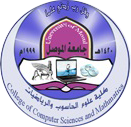17 March، 2024
A master’s thesis by Naz Fatih Mohamed Jameel

Discussion of a master’s thesis in the College of Computer Science and Mathematics – Software Department entitled:
“malware detection using deep learning”
In continuation of the movement of scientific research and in the presence and follow-up of the respected Mrs. Dean of the College of Computer Science and Mathematics
Respected Professor Dr. Duha Bashir Abdullah
It was discussed in the discussion hall of the College of Computer Science and Mathematics at the University of Mosul on Sunday 17/3/2024
Master’s thesis by Naz Fatih Mohamed Jameel Supervised by Dr. Muna Mohammad taher
The thesis submitted by the student deals with The thesis submitted by the student addressed malware and methods for detecting it. With the increasing dependence of users on smart devices, security threats have developed, and malware has become a major threat to the privacy and security of users. This malware is considered one of the most prominent electronic attacks and is constantly increasing its spread on the Internet. Due to the diversity and complexity of these attacks, it has become necessary to develop sophisticated defense methods. In this context, the role of deep learning and its techniques is highlighted, which provides powerful tools for accurate identification and classification of malicious software, which is considered a vital solution to confront contemporary security challenges. Currently, in the field of malware detection, the accuracy and efficiency offered by AI and deep learning methods are superior to traditional methods, pushing research in this field towards developing and improving these advanced technologies.
In this thesis, a new model was proposed for detecting malware, where a set of deep learning algorithms were used with a machine learning algorithm, such as a multi-layer neural network, a recurrent neural network, and a long short-term memory with a random forest algorithm. These algorithms were applied to dataset. It belongs to Ember, and performance metrics such as: accuracy, precision, and recall were used in the repository to evaluate the performance of the algorithms. The multi-layer neural network algorithm was hybridized with the random forest algorithm, and it became clear after comparing the performance evaluation of the algorithms that the hybrid algorithm is the best algorithm used in the detection process, as it obtained an accuracy of 91%. The research concludes that deep learning offers tremendous potential for enhancing cybersecurity and suggests paths for future research in this vital area.
The scientific committee included the following members:
- Dr. Baedaa Abrahem Kalel (University of Mosul) / chairman
- Associate Prof. Dr. Karam Hatem (University of Mosul) / Member
- Associate Prof. Shahad Abd alrahman (University of Mosul) / member
- Muna Mhammad taher (University of Mosul) / member and supervisor

















